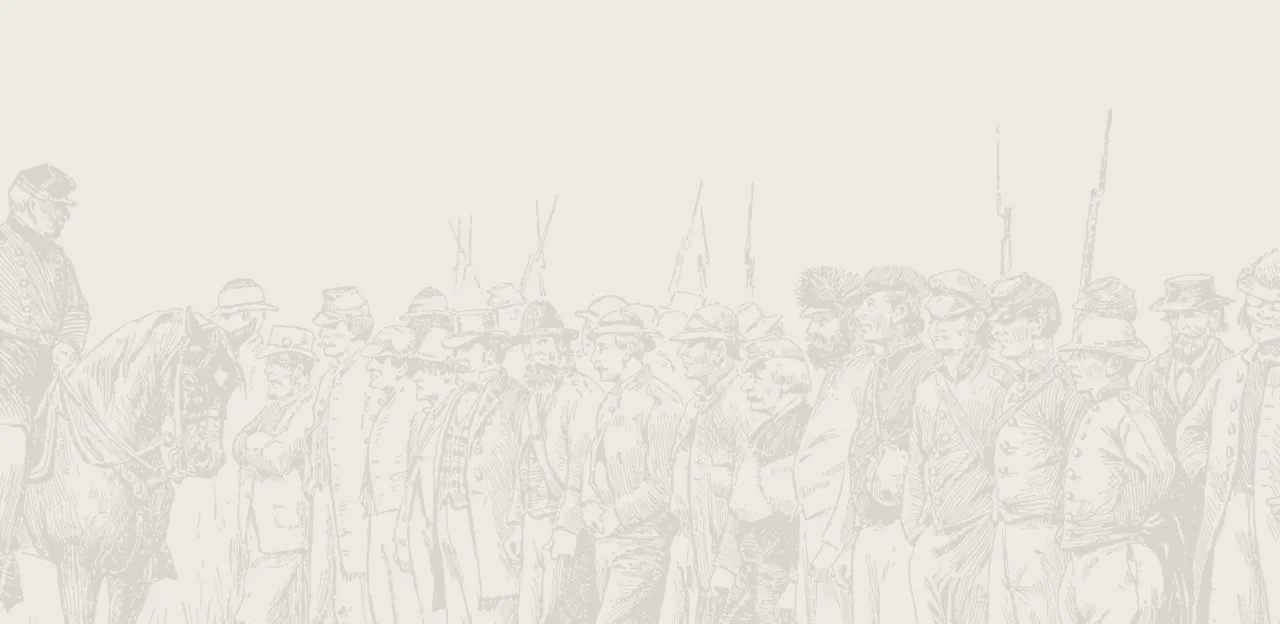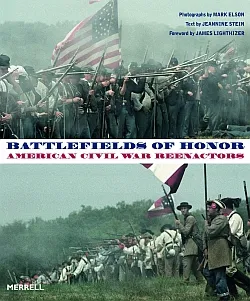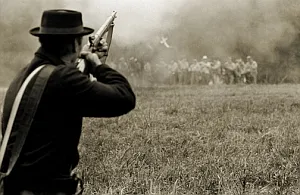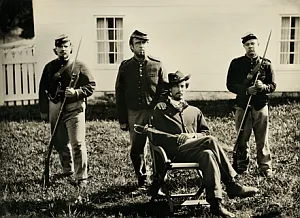Book: Battlefields of Honor

The Civil War Trust recently had the opportunity to talk with Mark Elson, whose recent book, Battlefields of Honor showcases authentic wet plate photographs of Civil War Reenactors.

Civil War Trust: You used wet plate collodion photography to produce many of the images in your book. Can explain this technique to us? Are all of the photographs in the book taken using this process?
Mark Elson: Wet plate photography was invented about 1851. This is a hands-on process where you create an image on a glass or metal plate. Some people are familiar with tin types—this is the same process that was used during the Civil War by well known photographers such as Mathew Brady, Timothy O’Sullivan, Alexander Gardner and Andrew J. Russell.
Unlike modern digital photography wet plate photography is very labor intensive and requires a portable darkroom and various chemicals. One of those chemicals is collodion, which creates a film on the plates. After the collodion is poured onto the plate, creating an emulsion, the plate is then placed into a silver bath to sensitize it.
Once you pour a plate and sensitize it you have about 10 minutes to expose and develop it, otherwise it will dry and be unusable. You place the wet plate in a holder in the camera - that's why it's called wet plate photography.
The cameras photographers use today for wet plate are salvages antiques or built from scratch. Either way, the lenses are from the period and lend a quality that no modern lenses can match.
While wet plate photographs can be seen throughout the book, I've also included color and black and white 35mm film photographs. I love silver-based photography for fine art. It has a quality and organic feel to it that is just beautiful. Since wet plate is also a silver process, all three work together seamlessly.
Why did you want to incorporate wet plate photography in the book?
ME: I wanted to experience what Civil War photographers went through to capture their images, and add another level of authenticity to the book by incorporating wet plate photography. I like knowing I'm carrying on an art and craft from 150 years into another century, where it's still relevant and appreciated.
What was your approach to photography reenactors?
ME: Before doing the book I spent a long time studying photographs from the Civil War and that period. My intnet wasn't to imitate those images, but to use them as an inspiration for my photographs.
For the portraits, I chose people who were believable in their look and were able to carry off their impression, be they soldier or civilian. Sometimes the person I photographed had an innate ability to pose in a way that looked authentic, and for others I had a specific idea in mind, and they graciously worked with me.
When I was shooting the action shots I never wanted to get in the way of the battle—I wanted to blend in as much as possible (I wore civilian clothes accurate to the period) so I didn’t disrupt the reenactors’ or spectators’ experience.
What's your favorite picture in the book?
ME: I don't neccesarily have a favorite photograph, but there is a series of wet plate pictures I took in the mountains in Southern California that I particularly like. I was part of an immersion event with authentic campaigners, and I felt like this was the type of situation a Civil War photographer would have shot. At an immersion event there are no spectators, and reenactors choose a scenario that can go on for days. In this case it was a Confederate camp in Tyler, Texas, in 1862.
We were in a remote area, much like during the Civil War, and being isolated allowed time and place to be blurred. I used a reproduction Mathew Brady camera and a portable wooden dark box (darkroom) about the size of large suitcase. Being in this area, shooting this event with a 19th century style camera and the same model lenses Brady would have used, gives the photographs a realistic look that allows the viewer to feel that same sense of engagement.

Has taking these pictures given you a better understanding of the lives of Civil War photographers?
ME: Definitely. Just the physicality of it—having to transport equipment and deal with various weather conditions—is tough. Weather has to be taken into consideration when doing this type of photography. Heat, cold, dust and humidity can all affect the photograph.
Doing wet plate also gave me a better appreciation for the artistry and daring of Civil War photographers. Before the war started many of these photographers led fairly comfortable lives, making their living by doing portraits. If you worked for Mathew Brady, as O’Sullivan and Gardner did, you might be shooting famous actors, senators, and even European royalty. But the fact that they put themselves in harm’s way in order to document this monumental American experience showed what great fortitude they had. Being on the battlefield during reenactments made me appreciate that all the more.
Marching around in the heat with heavy packs, rifles and uniforms is not an intuitive way for a person to spend his or her free time. Why do these people do it?
ME: Finding out why people like to reenact the Civil War was one of the reasons I wanted to do the book. Both my wife (jeannine Stein, who wrote the text) and I are fascinated by this aspect of reenacting.
Through talking to reenactors we found there are many reasons why people spend so much time and money to recreate the Civil War. Some people are history buffs, while others feel an intense connection to this period in the country's history. Many have relatives who served in the war, and they feel a personal bond with their family's past.
Many people are surprised to learn that reenacting the American Civil War is hugely popular in Germany, France, Italy, Sweden, and Australia. Even Americans go over to reenactments in England, which I photographed, to take part in reenactments.
Your book places emphasis on reenactors’ attention to historical accuracy, but also mentions that it varies among reenactors and their units. Why do many reenactors place such importance on authenticity?

ME: There are certainly different levels of reenacting and ways to get into the hobby. But some people, I discovered, enjoy it most when they can completely lose themselves in the experience, sleeping on the ground, eating food from the time, and wearing wool uniforms in the middle of summer.
Some of them may have started out being less true to the period, but eventually discovered that the real fun was in going all the way. It’s not just about being a fanatic for stitch counts on uniforms, but about having as close to an authentic experience as you can have 150 years after the fact.
Do you believe that it’s important to continue reenacting today?
ME: It’s not only important to continue reenacting today, but perhaps more important now than ever before. Each day we are further away from the Civil War, so it’s essential that we remember why this war was fought and how it forever changed our nation.
In a world changing by the minute, it’s essential to preserve American history. Many reenactments are held on actual Civil War battlefields, which brings a whole other dimension to the experience. These events also bring attention to the importance of battlefield preservation. If we don’t protect these historical sites they may be lost forever.
Buy the Book: "Battlefields of Honor" is available in our Civil War Trust-Amazon Bookstore
Mark Elson is a Los Angeles-based photographer and filmmaker who specializes in wet plate photography. He attended the College for Creative Studies (formerly the Center for Creative Studies) in Detroit, Michigan, and the American Film Institute in Los Angeles, California. He has been a lifelong student of the American Civil War.





